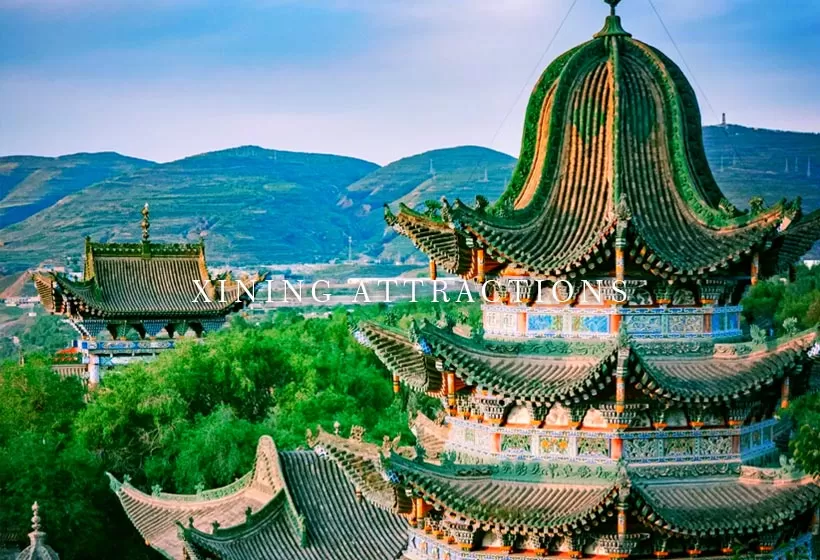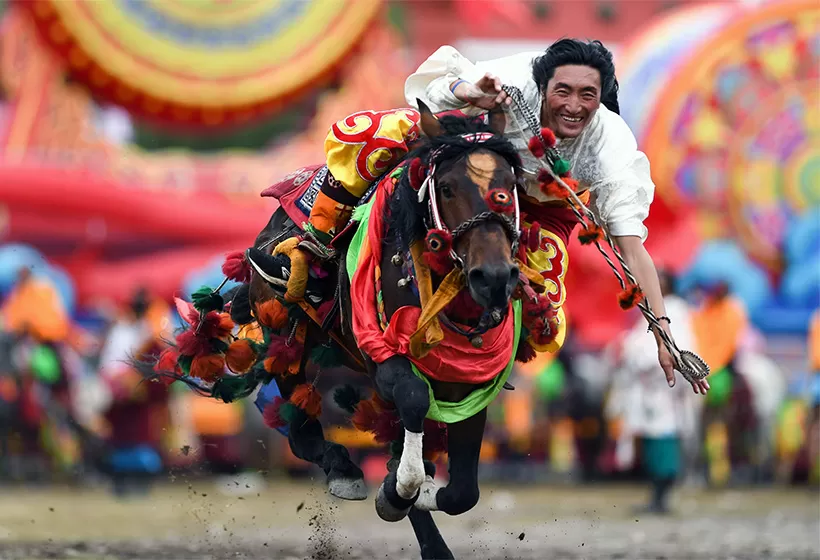Top 10 Famous Tourist Attractions and Sightseeing in Xining
For many travelers, Xining serves as a transportation hub on the way to Kumbum Monastery, Qinghai Lake, or further along the Qinghai-Tibet route to Lhasa. After gradually acclimating to the western region, most continue their journey toward Tibet.
However, Xining itself has places worth exploring. The Dongguan Mosque, Riyue Mountain, and Danggar Ancient City, each are unique and distinctive. Here are the Xining top 10 attractions.
Top 1: Qinghai Lake
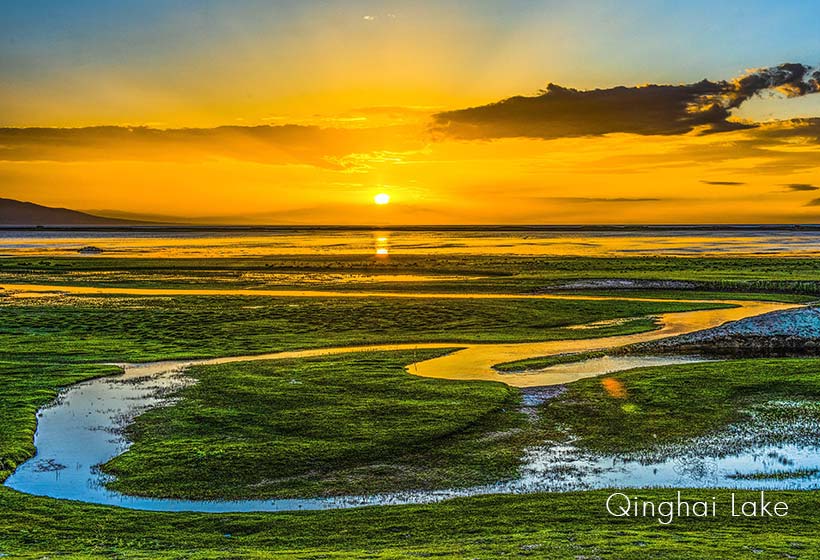 Qinghai Lake
Qinghai LakeQinghai Lake, located in the northeastern part of the Qinghai-Tibet Plateau, is the largest inland saltwater lake on the plateau in China, with 150 kilometers from Xining. The lake covers an area of 4,625.6 square kilometers, with a water volume of 74.3 billion cubic meters.
Qinghai Lake is one of the highest lakes in the world, with its surface elevation at 3,196 meters. The overall shape of the basin is elliptical, tilting from the northwest to the southeast, forming a closed inland basin, with its shape resembling a "soaring eagle".
Qinghai Lake is regarded as a "sacred lake" by the local Tibetan people, who hold the circumambulation of the lake in high regard as a religious practice. Devotees circumambulate the lake while performing prostrations as a way of showing reverence for nature and the divine.
Qinghai Lake is embraced by towering mountains, standing like majestic natural barriers that encircle the lake in guard. From the foot of the mountains to the lakeshore stretches a vast, flat, and boundless grassland. The expansive, misty waters of Qinghai Lake, with their endless blue waves, resemble a colossal jade plate nestled between the mountains and the grasslands, forming a splendid landscape where mountains, lake, and grasslands harmonize. When walking along the lake's shore, the vast blue hue stretches for miles. The sky serves as a canvas, and the water reflects the mirror-like image of the heavens, with the blue sky and white clouds mirrored in the lake. The blue of the water and sky merging as one, is the most mesmerizing beauty of Qinghai Lake.
- Address: north of No. 109 National Road, Gonghe County, Hainan Prefecture
- Open Hours: 00:00 AM – 12:00 PM
- Tour Length: 2-4 hours
Top 2: Bird Island
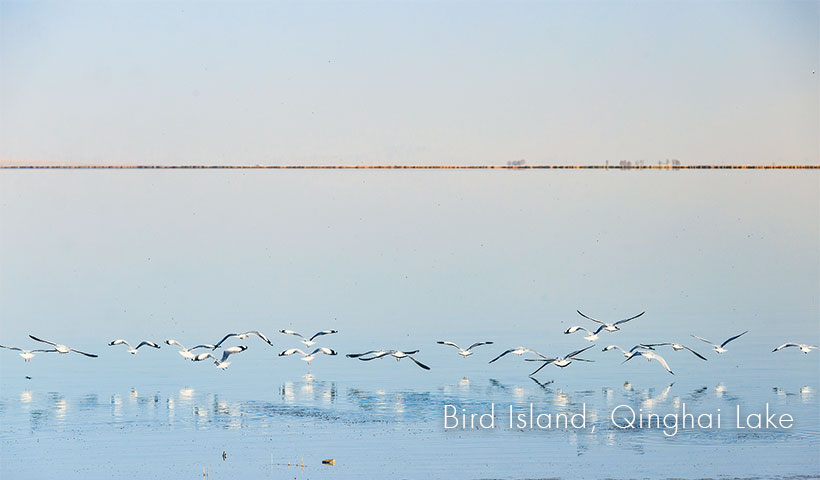 Bird Island
Bird IslandAt the northwest corner of Qinghai Lake lies Bird Island, near the entrance of the Buha River (the largest river in the Qinghai Lake system), named from the hundreds of thousands of migratory birds that inhabit it, divided into two parts: the eastern and western islands. The smaller western island, known as Haixi Mountain, also called Egg Island, rises 7.6 meters above the lake's surface shaped like a camel’s hump, where is home to around 80,000 to 90,000 birds. The larger eastern island, Haixi Island, is a kingdom of cormorants, with countless cormorant nests densely packed together, resembling a grand avian fortress, so Haixi Island is also known as Cormorant Island.
Surrounded on three sides by water and lush with vegetation, this island is home to tens of thousands of migratory birds. It is the most vibrant and spiritually charged place on the lakeshore. Every spring and summer, dozens of species of birds such as bar-headed geese, great black-headed gulls, brown-necked gulls, cormorant and ruddy shelduck migrate from South Asia, the Mediterranean, and other regions to build nests and breed on this island, whose melodious songs and graceful movements greet each day's sunrise and sunset. When birds soar over the lake, their figure blot out the sky, their calls echoing for miles, creating a scene of spectacular.
- Address: 4 km north of the mouth of Buha River, Gangcha County, Haibei Prefecture
- Open Hours: 08:00 AM – 06:00 PM
- Tour Length: 1-3 hours
Top 3: Kumbum Monastery
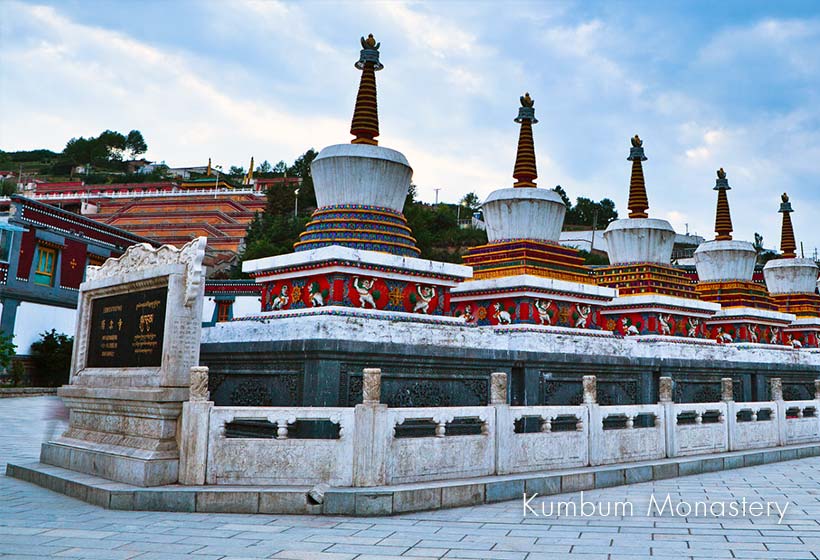 Kumbum Monastery
Kumbum MonasteryKumbum Monastery, also known as Ta’er Temple, was founded in 1379 during the Ming Dynasty. It is named after the large silver stupa built inside the Great Golden Roof Temple to commemorate the founder of the Gelug School of Tibetan Buddhism, Tsongkhapa. In Tibetan, it is called "Kumbum Jampa Ling", which means "The Maitreya Temple with the Ten Thousand Statue of the Siṃhanāda Buddha".
Kumbum Monastery is the center of Tibetan Buddhism in Northwestern China and one of the six major monasteries of the Gelug School (Yellow Sect) of Tibetan Buddhism. It is well-known in both China and Southeast Asia, and has been highly regarded by successive central governments for its religious status. During the Ming Dynasty, prominent religious figures in the monastery were granted titles, and during the Qing Dynasty, Emperor Kangxi and Qianlong has once bestowed plaques to the monastery.
The main buildings of Kumbum Monastery are nestled against the mountainside, with an arrangement of structures at varying heights, unique and grand style, blending both Han and Tibetan artistic elements. The monastery is renowned for its "Three Treasures of Kumbum Monastery"—the yak butter sculptures, murals, and embroidery. In addition, the monastery houses numerous Buddhist scriptures as well as scholarly works on subjects such as history, literature, philosophy, medicine, and law.
- Address: No. 56 Jinta Road, Huangzhong District, Xining
- Open Hours: 07:30 AM – 06:30 PM
- Tour Length: 2-5 hours
Top 4: Dongguan Mosque
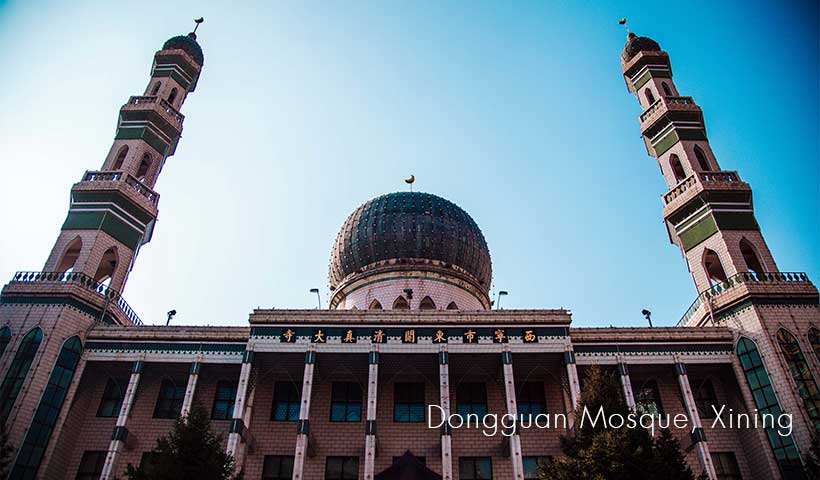 Dongguan Mosque
Dongguan MosqueThe Dongguan Mosque covers an area of 11,940 square meters and is the largest and best-preserved ancient building in Xining. It was built in 1380 during the Ming Dynasty and is one of the five main mosques of Islam in China, as well as one of the four major mosques in the Northwest region.
The complex of the Dongguan Mosque blends traditional Chinese classical architectural styles with Islamic architectural features and modern design elements, creating a harmonious fusion of the three. Looking at the layout and architectural style of the mosque, one must pass into the rear courtyard to officially enter the mosque. The rear courtyard features a primarily Chinese-style ancient architectural design, while the gates incorporate varying Western architectural styles.
The roof of the prayer hall is decorated in a distinctive manner, with colorful glazed tiles and small green tiles adorning the top, and a ceramic "Two Dragons Playing with a Pearl" decoration placed above. At the center of the hall’s ridge stands three gilded vases (sutra tubes gifted by the Labrang Monastery in Gansu), and on either side of the five main gates, there are also vases atop the minaret towers (sutra tubes gifted by Ta'er Monastery). These elements, combined with the overall layout of the hall, make a unique architectural style that is rarely seen in mosques across China’s Islamic structures.
- Address: No. 31 Dongguan Street, Chengdong District, Xining
- Open Hours: 07:00 AM – 08:00 PM except for Friday
- Tour Length: 1-3 hours
Top 5: Riyue Mountain
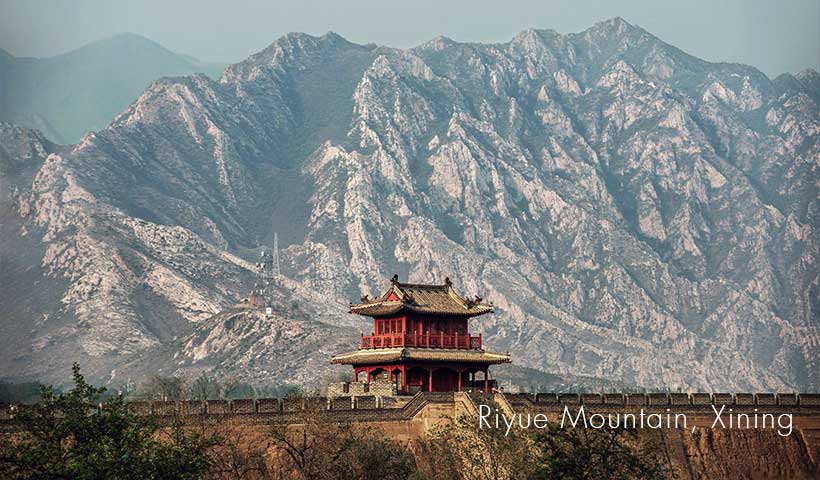 Riyue Mountain
Riyue MountainRiyue Mountain has long been the gateway to Tibet from the inland regions, earning it the titles "Gateway to the Grasslands". Part of the Qilian Mountain range, it stretches 90 kilometers and serves as a natural dam to the east of Qinghai Lake, with an average elevation of around 4,000 meters.
Throughout history, Riyue Mountain has been a key route along the "Southern Silk Road" and the "Tang-Tubo Ancient Road", witnessed numerous historical events, including alliances, marriages of state, wars, and trade of tea-salt and tea-horse.
Situated at the convergence of the Loess Plateau and the Qinghai-Tibet Plateau, Riyue Mountain is the natural boundary separating the inner and outer river basins of Qinghai, marking the divide between agricultural and nomadic civilizations. To its east lies Qinghai's farming region, with its orderly fields and a landscape reminiscent of southern China. To its west stretches an endless expanse of pastureland, with vast grasslands dotted with herds of cattle and sheep, painting a classic frontier scene. The summit of Riyue Mountain is composed of purple sandstone from the Tertiary period, giving it a reddish hue of being anciently known as "Red Ridge". Through the Riyue Mountain lane, is the path taken by Princess Wencheng to Tibet for her political marriage, that is the Tang-Tubo Ancient Road. Alongside the ancient road stand the Princess Wencheng Memorial Hall, inside which, statues of Songtsen Gampo and Princess Wencheng are enshrined.
- Address: 40 km southwest of Huangyuan County, Xining
- Open Hours: 08:00 AM – 05:00 PM
- Tour Length: 1-2 hours
Top 6: Tang-Tubo Ancient Road
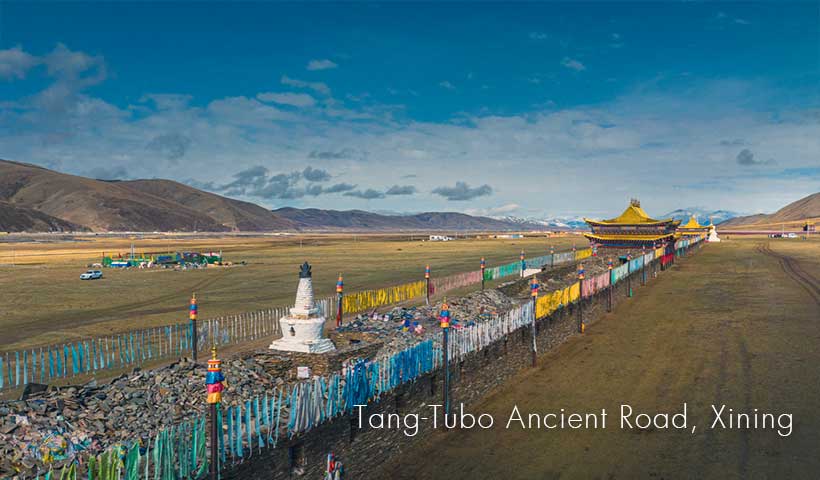 Tang-Tubo Ancient Road
Tang-Tubo Ancient RoadThe Tang-Tubo Ancient Road was a famous transportation route in ancient China. It served as the path to Tibet 1,300 years ago and was the main passage from the Central Plains to Qinghai, Tibet, and even Nepal and India since the Tang Dynasty. The renowned Princess Wencheng traveled this road when she married the Tibetan King Songtsen Gampo.
The Tang-Tubo Ancient Road starts in Xi'an, Shaanxi (formerly Chang'an), passes through Gansu and Qinghai, and extends to Lhasa, Tibet (formerly Lhoka), spanning over 3,000 kilometers. More than half of this route lies within Qinghai, where Xining serves as the dividing point between its eastern and western sections, that the western segment is particularly treacherous, with rugged terrain and an unpredictable, harsh climate. Stretching across western China and traversing the "Roof of the World", linking China to its southwestern neighbors, earning it the name "Southern Silk Road".
Even today, many historical relics such as ancient post stations, cities, villages, and monasteries remain along the route. Nowadays, much of the Tang-Tubo Ancient Road within Qinghai has been reconstructed into National Highway 214, along which the rich Tibetan culture and stunning plateau landscapes are now fully unveiled to the world.
- Address: G214 National Highway, Xining
- Open Hours: 00:00 AM – 12:00 PM
- Tour Length: 1-3 hours
Top 7: Danggar Ancient City
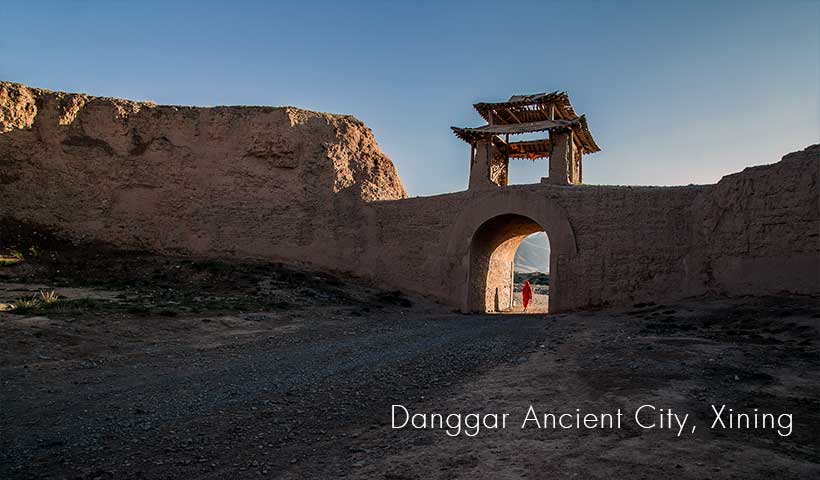 Danggar Ancient City
Danggar Ancient CityDanggar Ancient City, meaning "White Conch" in Tibetan, is located on the northern bank of the Yellow River, near the shores of Qinghai Lake and at the source of the Huangshui River, about 40 kilometers from Xining. Established during the Hongwu period of the Ming Dynasty, the city boasts a history of over 600 years. Since the Western Han Dynasty, it has gradually evolved into a key hub where commerce, military affairs, religion, and folk traditions intersect, renowned as the "Gateway to Qinghai and Tibet", the "Tea and Horse Trading Capital", and the "Little Beijing".
The ancient city’s main street, less than a kilometer long, connects significant landmarks such as the City God Temple, the Confucian Temple, and the Danggar Hall. The city features a maze of crisscrossing alleys, uniquely structured courtyard residences, grand monasteries and temples, well-preserved traditional "Xiejia" merchant shops, and the distinctively styled Huangyuan lanterns, all these elements embody the city's deep and diverse culture.
- Address: Mingqing Old Street, Huangyuan County, Xining
- Open Hours: 08:00 AM – 06:00 PM
- Tour Length: 1-2 hours
Top 8: Mojia Street
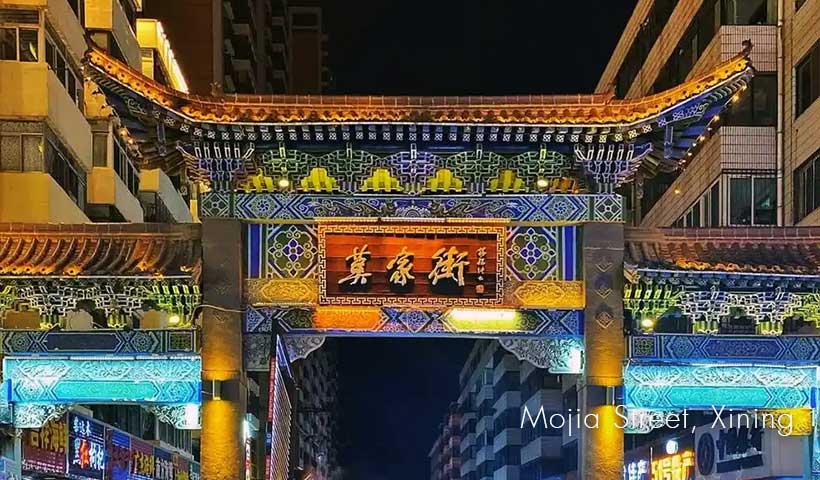 Mojia Street
Mojia StreetMojia Street, with a history of over 600 years, is one of the oldest streets in Xining and a famous food street in the city. It is a paradise for food lovers, lined with numerous shops offering a rich variety of local delicacies. Visitors can savor an array of snacks, all showcasing the distinctive flavors of the Great Northwest, making it an unmissable destination for visitors exploring Xining.
The origin of Mojia Street is debated, but all versions of the story are linked to the Mo family. According to legend, during the late Yuan Dynasty, amidst the chaos of competing warlords, Mo De sought refuge with Zhu Yuanzhang. He later achieved numerous military successes and was granted the hereditary title of Commander of Xining Garrison by the Ming Dynasty, overseeing the city. Afterwards, his son, Mo Yun, succeeded him and was further promoted to Deputy Commander due to his merits. Since the title was hereditary, Mo’s descendants established their private residence in the area now known as Mojia Street and built the Mo Ancestral Hall nearby. The hall became known as "Mo Family Temple", and over time, the street in front of it gradually came to be called Mojia Street.
- Address: South side of East Street, Chengzhong District, Xining
- Open Hours: subject to the opening conditions of the day
- Tour Length: 2-3 hours
Top 9: Black Spring Reservoir
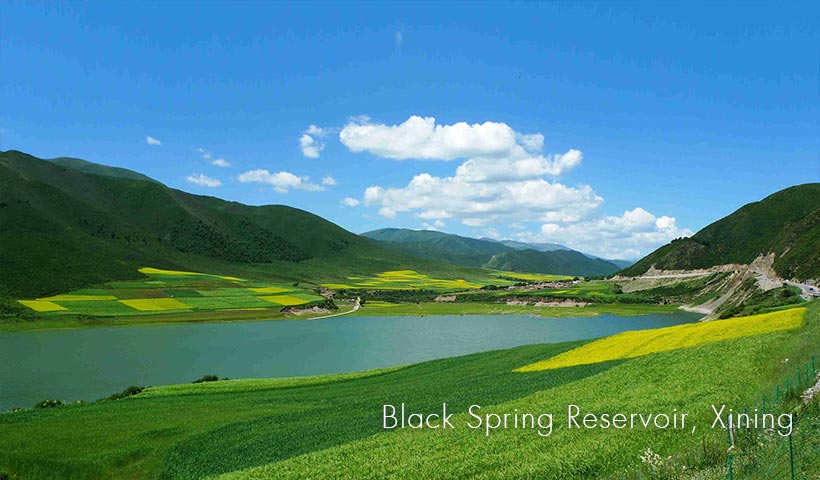 Black Spring Reservoir
Black Spring ReservoirLeaving Xining and driving north for about 75 kilometers along winding mountain roads, the Black Spring Reservoir is nestled among towering peaks like a sparkling gem. It is home to the mysterious "Divine Light of the Setting Sun" and a naturally eroded statue resembling the Maitreya Buddha, making it one of the key attractions on Qinghai’s northern tourist route, where crossing over the Daban Mountain lies Menyuan County with rape flowers stretching for miles.
From spring to autumn, "a calm lake emerging from a high gorge" perfectly captures the essence of Black Spring Reservoir, whose 5.34-square-kilometer water surface reflects the surrounding lush green mountains and valleys. As you take in the scenery, the snow-capped peaks of the Qilian Mountains in the distance harmonize with the gentle curves of the nearby landscape, looking so bright and beautiful.
- Address: near G227 National Road, Baoku Village, Datong County, Xining
- Open Hours: 00:00 AM – 12:00 PM
- Tour Length: 1-3 hours
Top 10: Plateau Pearl
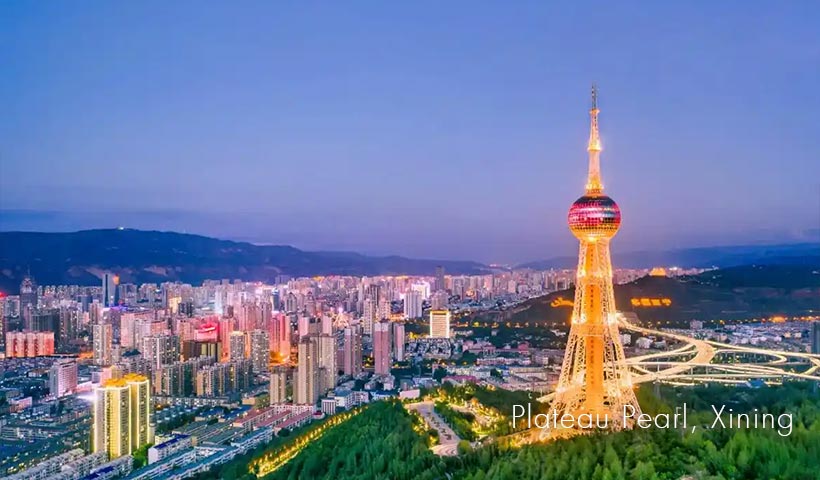 Plateau Pearl
Plateau PearlThe Plateau Pearl, also known as the Puning (Pudong-Xining) Pearl, is a sightseeing tower built with support from Shanghai’s Pudong New Area as part of its aid to the western regions, so its name combines the abbreviations of Pudong and Xining.
Situated on Xishan Mountain in the southwestern part of Xining, the tower is a prominent city landmark, easily visible from within the urban area. Standing at 188 meters tall, the tower features a structure composed of four triangular-sectioned steel lattice columns, a spherical observation deck, and a sturdy base. The observation sphere has a diameter of 26 meters and houses five floors.
From the top of the tower, visitors can enjoy a panoramic view of Xining, offering the best vantage point in the city. High-powered telescopes are available for free use, allowing visitors to enjoy the sweeping city views during the day and the dazzling nightscape after dark. As a prime location for sightseeing, business meetings, dining, and leisure, the Plateau Pearl has become the Xining’s city balcony.
- Address: No. 7, Xishan Lane 1, Chengxi District, Xining
- Open Hours: 10:30 AM – 11:00 PM
- Tour Length: 1-3 hours
Customize Your Unique Summer City Xining Tour
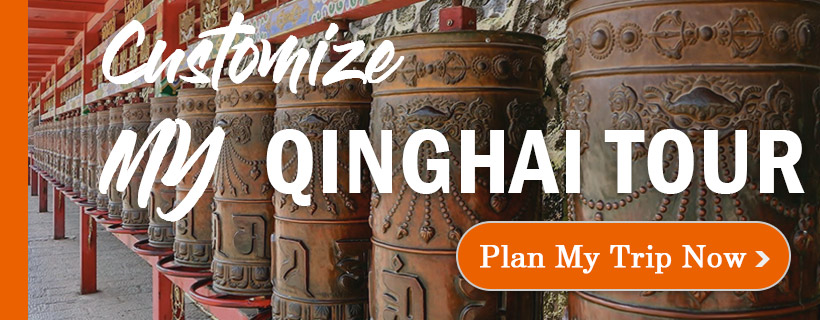
If you are interested in the Xining itineraries mentioned above, please contact us, and we will be happy to customize it and provide a quote tailored to your preferences.
Alternatively, if you would like to customize your Xining Tour, please visit our Xining Tour Customized Center. We assure you that you will receive a reply within 24 working hours.
Informative Articles for Your Xining Trip
 Prayer Flag
Prayer Flag- Travel Guide: attractions, weather, hotels, food, etc.
- Weather: the best time and seasons to visit Xining
- Top attractions: sightseeings to watch in Xining
- Local culture: brief history, folk culture, nations, etc.
- Top destinations: best places to visit in Xining
- Travel itineraries: itineraries for your reference
- Unique perspective: top interesting things to do
- Local food: what to eat while traveling in Xining
- Luxury hotels: accommodation to stay in Xining
- Xining Tours: customized tours for your reference
GREAT FAMILY CHINA TOUR
JULY 2024 We wanted to thank Grace at China Culture tour for organizing a great tour of China. We enjoyed our Beijing - Xian-Chengdu -Guilin -Yangshuo - Shanghai trip. Our local guides Bruce in Beijing, Susan in Xian, Jane in Chengdu, Mike in Guilin and Mary in Shanghai took care of us…read more details »
Teng Han L from SINGAPORE
Ready to Create a Unique Dream Travel?
